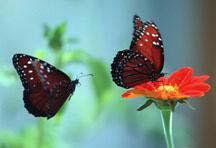
by Mary Salinas | Jul 7, 2015
Butterflies are not only beautiful to look at in your landscape; they serve as important pollinators and indicators of the health of our environment. Attracting them to your garden and incorporating some features to get them to stay and make it their home involves a little planning ahead of time for optimum results.

Queen butterfly. Photo credit: Milt Putnam, UF/IFAS.
Choose a location that provides some protection from wind. Trees and shrubs that provide wind protection also serve as a safe harbor from rain and predators. The garden should be mostly sunny with some part sun areas. Ensure that any new plantings have access to a convenient irrigation source so they can be successfully established and maintained in good health.
Now you’ll need to choose the plants. Adults feed on the nectar of many flowering trees, shrubs, perennials, and annuals and, fortunately, there are usually many choices that will meet your site requirements and your taste preferences. In order to keep the butterflies in your garden, certain plants need to be available to serve as host plants for their young. Determine which species of butterfly is common in your area and that you want to attract. Most species have very few plants on which the caterpillars can feed so those host plants need to be chosen wisely. Determine whether any of the plants you already have are host plants and they can be integrated into your butterfly garden. For example, cassia is a host plant for the Cloudless Sulphur and citrus is a host plant for the Giant Swallowtail.
In choosing your nectar plants, select those that are native or Florida-Friendly as they are lower maintenance, giving you less trouble in the long run. Choose plants that have flowers in a variety of color, size, and shape. Different butterflies like to feed at different elevations, so choose trees, shrubs, perennials, and annuals of varying heights. In order to have nectar available throughout the time when the butterflies occur, include plants that bloom at different times of the year. And include some plants that bloom from spring to late fall, like pentas or moss verbena.
Larger plants should be placed in the background with smaller plants layered in the foreground. When you plant smaller annuals and perennials, place them in masses to better attract the butterflies. Consider placing host plants in an area that is in close proximity to the nectar plants, but in an area of your garden that is not a focal point. Host plants can get quite ragged looking from hungry caterpillars!
Good maintenance practices will enhance the health of your garden. Regular fertilization and irrigation if needed will help keep your plants in bloom and healthy; healthy plants are less susceptible to disease and pests. Avoid pesticides as they may harm the very creatures you are trying to attract. Never use Bt or systemic pesticide. If you must, target a pest with lower risk oils or soaps and then only treat the affected plants. Lastly, be aware of beneficial insects that will help you achieve satisfactory control of a pest.
Now that your plants are placed there are several things to do to make your butterfly garden complete. Add a spot where water can puddle on the ground for the adult butterflies to drink. They require minerals from the soil that get dissolved in the water. Also add a rock or log in a sunny spot where butterflies can rest and sun themselves. And consider placing a comfortable place for you to sit and enjoy the beauty of your garden and its inhabitants!
For more information:
Butterfly Gardening in Florida
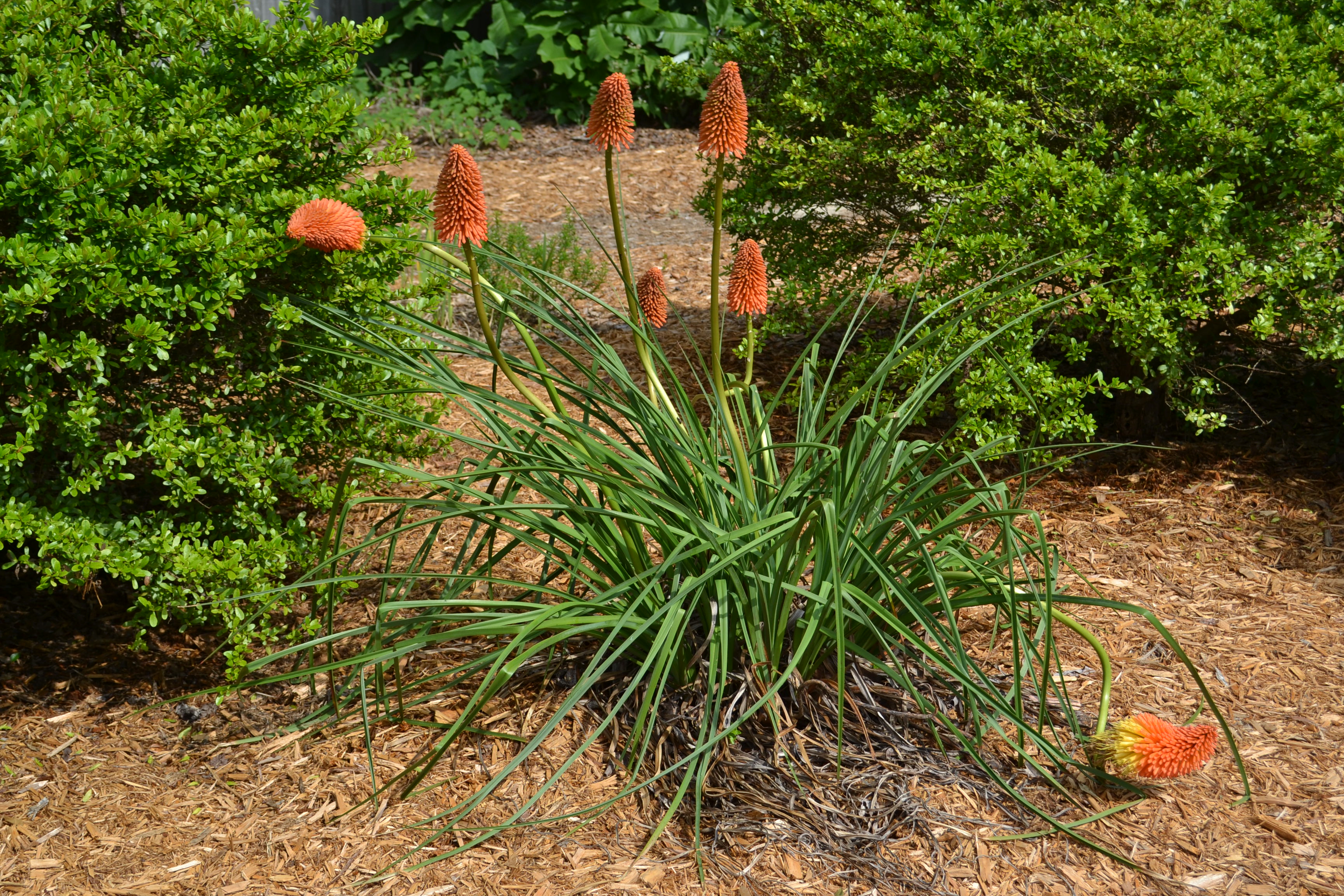
by Beth Bolles | Jun 3, 2015
If you are looking for flower colors to match the heat of June, Red hot poker, Kniphophia uvaria has the blooms that match the season. Also known as the torch lily, this perennial performs well in full sun areas with well-drained soil. Leaves about 3 feet long and 1 inch wide form a clumping plant over the years to about 3 feet in height and 2 feet in spread.
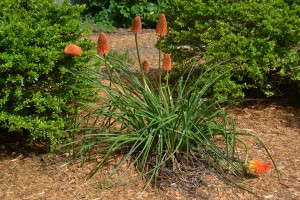
The highlight of the plant are the flowers that form in May and June. Stalks grow above the foliage holding clusters of tubular flowers that emerge red/orange and mature to yellow. Flowers are often in transition between the two colors. Remove flowers after they fade.
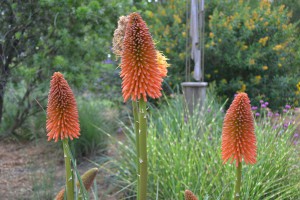
Red hot poker is a low maintenance plant along the Gulf Coast. Extreme cold may set plants back a little but clumps grow well during winters with average cold temperatures. Plants can be divided after several years but the bloom cycle may be delayed following this practice.
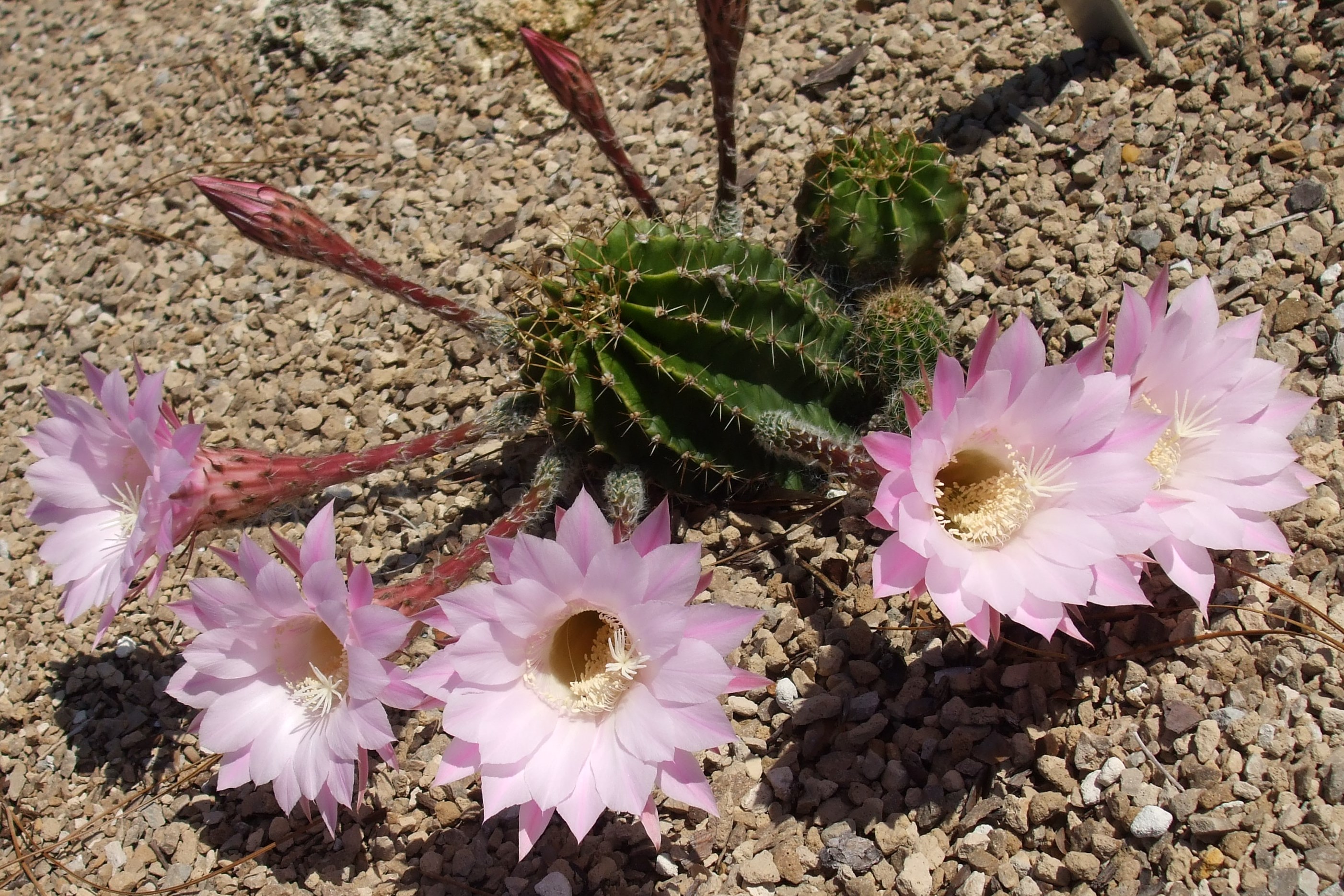
by Gary Knox | May 26, 2015
Summer is here, along with its heat, humidity, drought and stress! One easy way to garden during summer is to use succulents and other drought adapted plants.
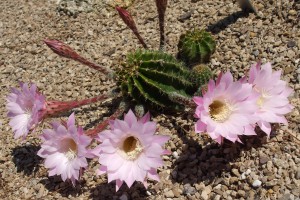
The sea urchin cactus (Echinopsis spp.) produces large, stunning flowers.
Succulents are heat-adapted, water-efficient plants often associated with deserts and dunes. Usually succulents have thick leaves or stems that store water. A cactus is a familiar type of succulent, as are agave, aloe, yucca as well as bromeliads like dyckia. Other dry-adapted plants can retreat into bulbs, rhizomes or other thick plant parts to go dormant until rains resume. A few other strategies used by plants to save water include: waxy or hairy coverings to reduce water loss; extensive root systems to absorb water; and silver- or blue-colored leaves and stems to reflect light and reduce heat.
Succulents’ tough qualities make them well-adapted to the harsh conditions of urban living amid concrete, brick, asphalt and other “hardscapes”. This adaptability translates into low maintenance since they need little or no irrigation, fertilization, pruning or spraying. Do you like container gardens? Succulents are almost the perfect container plant, because they hardly ever need watering!
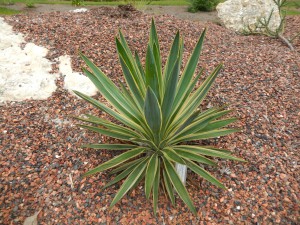
The American century plant (Agave americana) is a large growing succulent with silver-grey leaves.
Above and beyond their toughness, succulents capture our imaginations because they are often dramatic, dangerous and slightly unpredictable. Drama stems from the architectural forms of many thick-leaved plants like agave. Danger arises from the thorns and spines of plants like cactus. Unpredictability results from bulbs and perennials that can quickly explode into flower, and then disappear just as suddenly. Often succulents have outrageous flowers with wild, bold colors and strange shapes!
While many succulents are native to deserts, others are Florida natives where they can be found in coastal dunes or in areas with sandy soils that have little water-holding capacity. For example, many native yuccas are excellent succulents for use in dry gardens or in containers.
For best growth and appearance, most succulents require well-drained soil and full sun (at least 6 hours of direct sunlight per day). Succulents are ideal plants for garden beds near roads, sidewalks, driveways and south-facing walls because they tolerate limited soil moisture, higher soil pH and reflected heat and light usually associated with these areas. On the other hand, try to avoid planting succulents in shady areas, wet areas, low areas that collect water and areas with heavy soils.
Summer gardening is easy with succulents!
For more information:
Agave and Yucca: Tough Plants for Tough Times
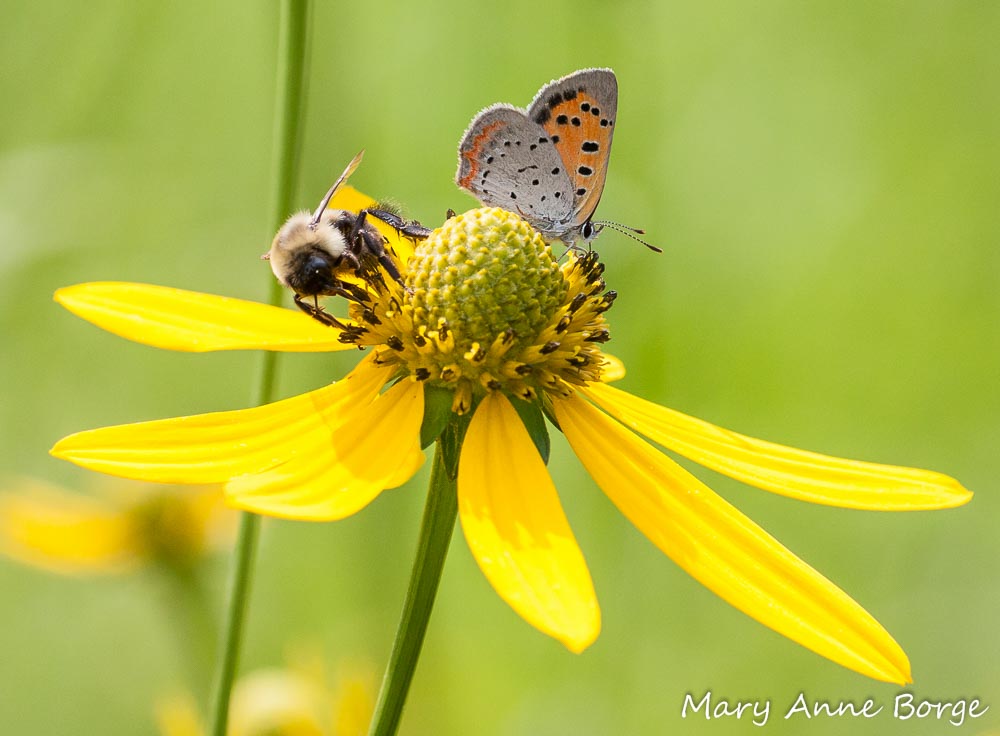
by Sheila Dunning | May 22, 2015
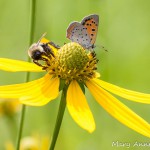 Everyone with a landscape can make a difference for pollinators. Simply Having Areas Reserved for the Environment enables homeowners, land managers, farmers, individuals, corporations, schools, roadside managers, and golf courses to increase the number of pollinators in the area by making conscious choices to include plants that provide essential habitat for bees, bats, birds, butterflies, moths, beetles, and hummingbirds. What better time than during National Pollinator Week, June 15-21, 2015.
Everyone with a landscape can make a difference for pollinators. Simply Having Areas Reserved for the Environment enables homeowners, land managers, farmers, individuals, corporations, schools, roadside managers, and golf courses to increase the number of pollinators in the area by making conscious choices to include plants that provide essential habitat for bees, bats, birds, butterflies, moths, beetles, and hummingbirds. What better time than during National Pollinator Week, June 15-21, 2015.
Initiated and managed by the North American Pollinator Protection Campaign, National Pollinator Week was unanimously approved and designated by the U.S. Senate in 2007. Each year since, the U.S. Secretary of Agriculture has signed the proclamation in an effort to address the urgent issue of declining pollinator populations.
Worldwide there is evidence that pollinating animals have suffered from loss of habitat, pesticide misuse, competition from invasive species, disease, and parasites. Many pollinators are federally “listed species”, meaning that there is documented information confirming the disappearance and/or significant population reduction in natural areas. The United States has lost over 50% of its managed honeybee colonies over the past ten years. The European Union has been so concerned that they invested over $20 million investigating the status of pollinators in Europe.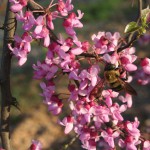
Pollinator health affects everyone. Worldwide, roughly 1,000 plants grown for food, beverages, fibers, spices, and medicines need to be pollinated by animals in order to produce the goods on which we depend. Food and beverages produced with the help of pollinators include: apples, blueberries, chocolate, coffee, melons, peaches, potatoes, pumpkins, vanilla, almonds, and tequila. In the U.S., pollination by honey bees, native bees, and other insects produces $40 billion worth of products annually.
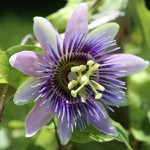 The native plants that can be identified and preserved or introduced include trees, shrubs, vines and perennials. Some of them include: Eastern Redbud (Cercis canadensis), Highbush Blueberry (Vaccinium spp.), Passionflower (Passiflora spp.), Coreopsis (Coreopsis spp.), Goldenrod (Solidago spp.), Black-eyed Susan (Rudbeckia hirta), and Butterfly Milkweed (Asclepias tuberosa). Simply identifying and avoiding damaging many of the existing native plants will allow anyone to provide important homes and food for many different pollinating animals. During National Pollinator Week S.H.A.R.E. your space.
The native plants that can be identified and preserved or introduced include trees, shrubs, vines and perennials. Some of them include: Eastern Redbud (Cercis canadensis), Highbush Blueberry (Vaccinium spp.), Passionflower (Passiflora spp.), Coreopsis (Coreopsis spp.), Goldenrod (Solidago spp.), Black-eyed Susan (Rudbeckia hirta), and Butterfly Milkweed (Asclepias tuberosa). Simply identifying and avoiding damaging many of the existing native plants will allow anyone to provide important homes and food for many different pollinating animals. During National Pollinator Week S.H.A.R.E. your space.
For additional information:
UF Native Buzz
Gardening for Pollinators
Minimizing Honey Bee Exposure to Pesticides
The Xerces Society
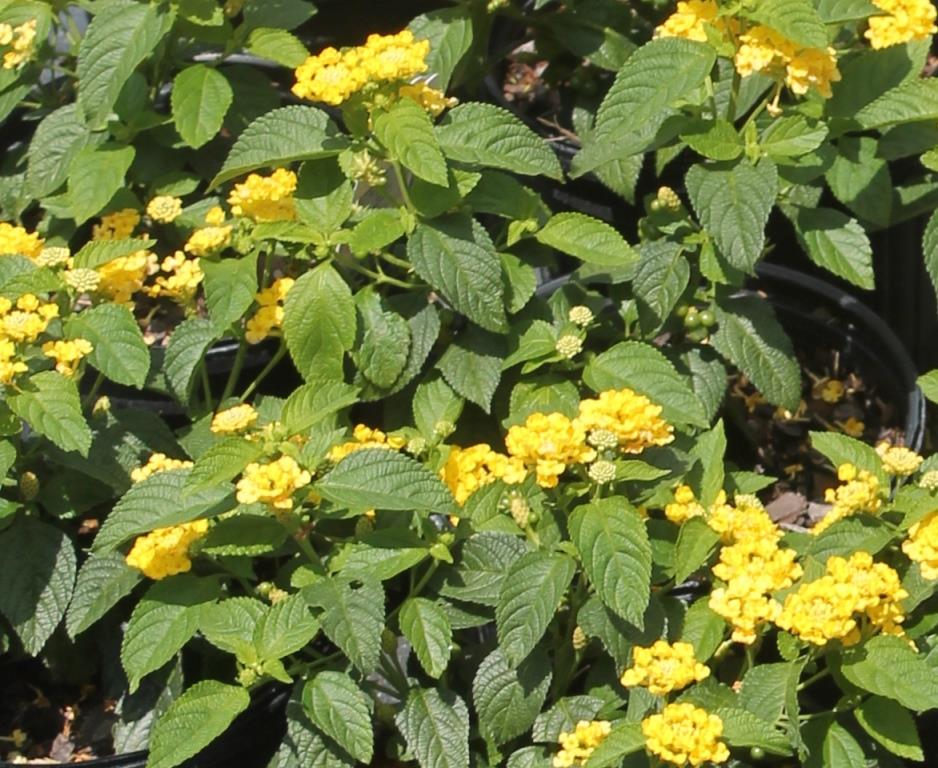
by Matthew Orwat | May 19, 2015
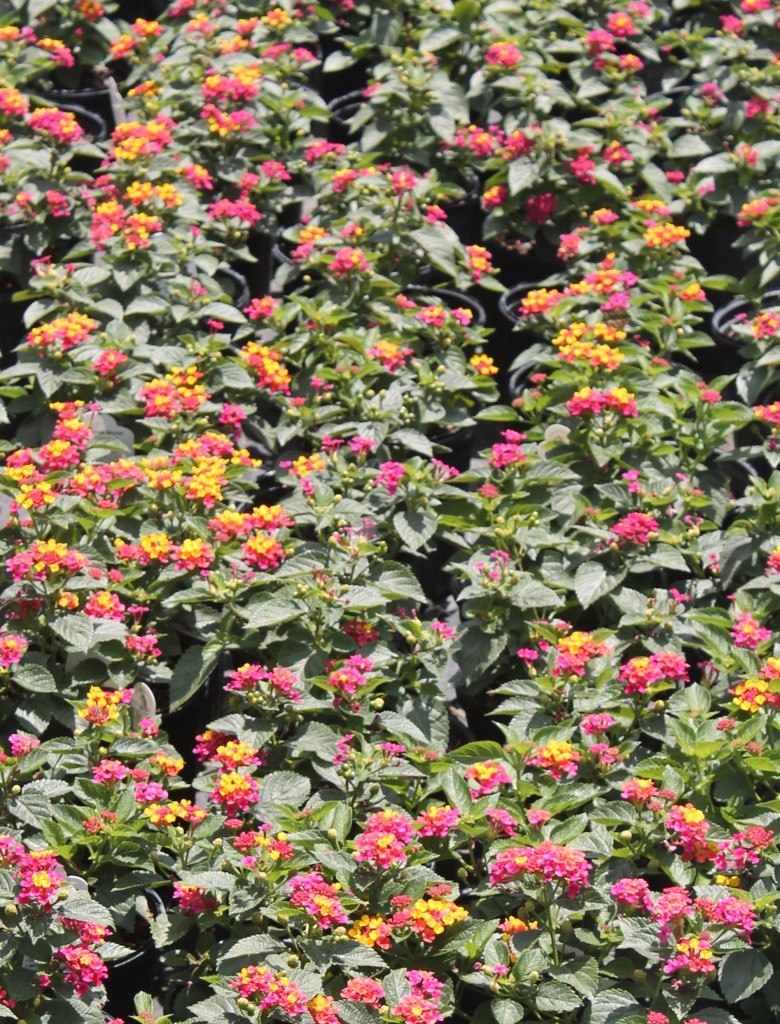
Dwarf lantana – Image UF IFAS Extension, Matthew Orwat
With the heat of summer already here, we all know that our pansies, petunias and snapdragons are on their way out. This leaves us wondering what we could plant that will give us color throughout summer and fall to the first frost.
Many are weary of Lantana camara, the common garden lantana, because of its potential as an invasive species and large rampant size. Good news, there are several dwarf cultivars that have no invasive potential because they are sterile. Additionally, many other dwarf cultivars grow slow and produce few seed, so they have low invasive potential.
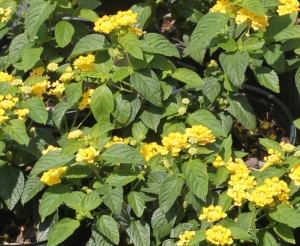
Dwarf lantana. Image credit UF/IFAS, Matthew Orwat
Northwest Florida is not in the natural range of the endangered South Florida native Lantana depressa, so the outcrossing danger does not exist in our area.
Dwarf lantanas are available in either mounding or trailing types. Mounding types rarely get over 1 foot tall and have an equal spread while trailing lantanas stay lower to the ground but can spread several feet. They are available in several colors including yellow, purple, white, multicolor and red. They provide reliable color in flushes from late spring until first frost
When mature, dwarf lantana are drought tolerant but need supplemental watering to get established. They also thrive in poor soils and need little fertilization.
Dwarf lantana usually acts as a perennial, but die to the roots during extremely cold winters.
Lantanas that are known to be relatively non-invasive include Patriot, Hallelujah, Sunburst, and Cowboy. Florida Exotic Pest Plant Council recognizes the cultivars ‘Gold Mound’, ‘New Gold’, ‘Alba’ and ‘Patriot’ as cultivars that are not known to produce viable seeds. Other newer dwarf varieties need to be evaluated on a case by case basis, but varieties the author has observed as no to low seed set in the landscape. Also if home gardeners are worried about seed production, spent blooms can be pinched off so no seed can form. This pinching off practice also speeds up re-bloom and is thus highly encouraged.
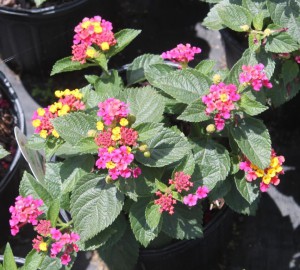
Dwarf lantana – Matthew Orwat, UF/IFAS
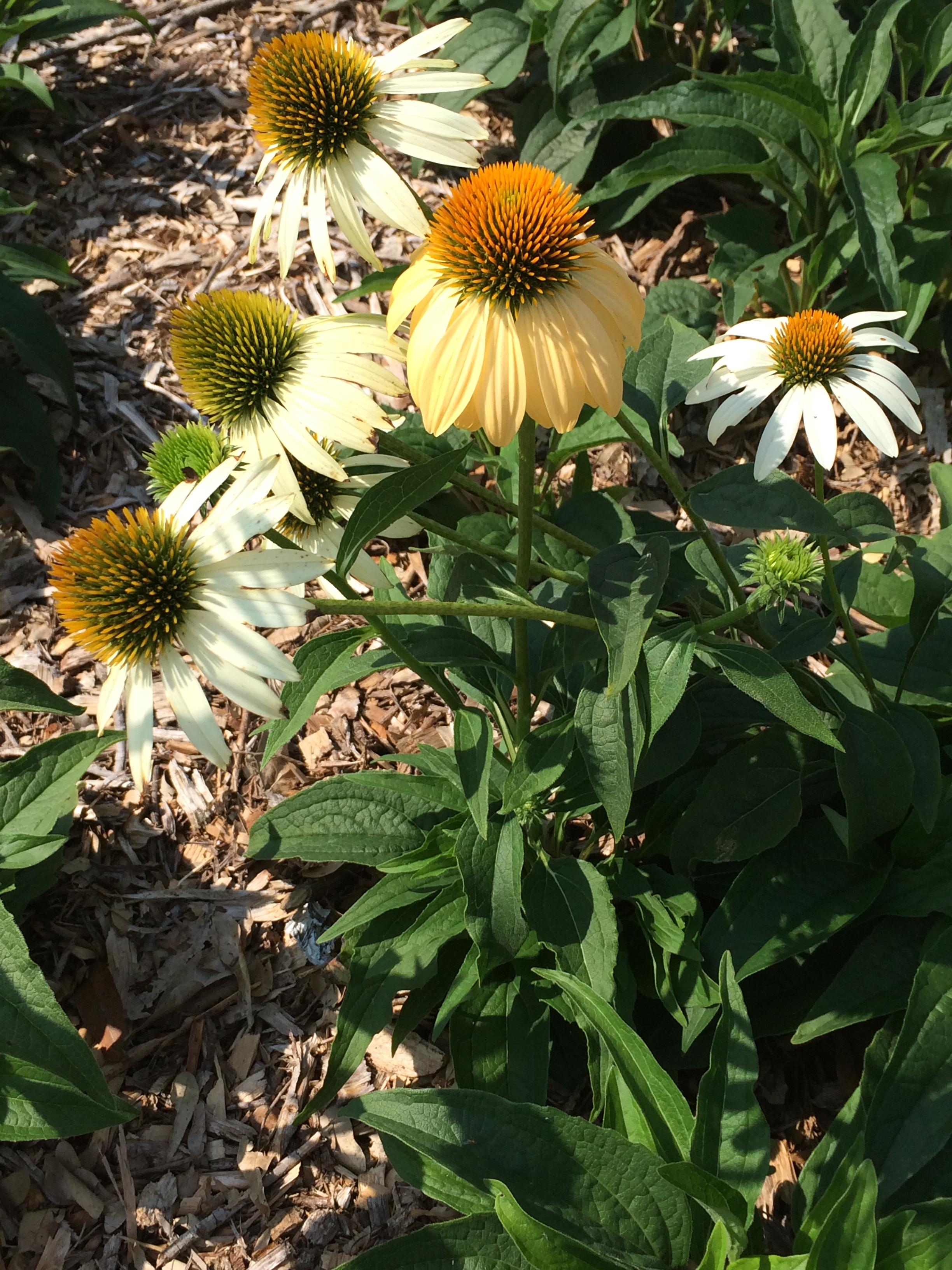
by Mary Salinas | May 12, 2015
An easy to care for perennial to add to your flower garden is the coneflower, Echinacea purpurea. The daisy-like flowers stand tall above the foliage on sturdy 2 to 4 foot stems. Blooms appear about the last part of April or the first of May in the Florida panhandle and last throughout the warm season until late fall. This Florida native reliably comes back year after year. Plant coneflower in part to full sun in rich but well-drained soil for best results.
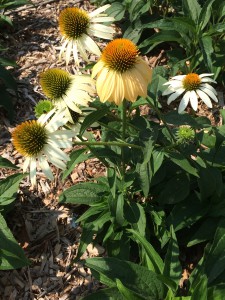
White coneflower. Photo credit: Mary Derrick, UF/IFAS Extension.
Coneflowers are traditionally purple but many new colors and variations of their form have become available from the horticultural industry. You can find them in white, yellows, pinks, oranges, and greens as well as all shades of lavender and purple. No matter what color you choose, the blooms will attract a host of butterflies and other pollinating insects. In order to protect these delicate creatures, avoid the use of pesticides when they are present.
Once you have a few coneflowers, you will notice that the clumps will grow in time and new plants will sprout from seeds left behind by the spent blooms. In our demonstration garden, this has created a stunning display that has been allowed to take over one of the garden beds. When any one clump gets too big, the number of blooms can decrease and it may be time to dig up the clump and divide it. This is a great opportunity to expand your coneflower bed or share them with some friends or neighbors!
For more information:
Ornamentals for your landscape
Butterfly Gardening

















